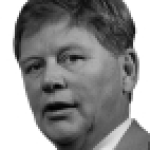On the occasion of the 40th anniversary of Compact, already several years ago, I concluded that at this time it was very difficult, if not impossible, to predict development in technology. A tour along CIOs at the time confirmed this, one of the quotes that I recall was: “I have a clear picture of what will happen in the coming three to six months, at the most. What will happen after that depends on several factors about which I currently have an insufficient overview.”
My conclusion was that three to six months is an incredibly short period to solve the substantial investment issues around IT and its relatively long lifespan. Uncertainty around strategic investment decisions is therefore extremely high. Accordingly, it is not so extraordinary to seek solutions in outsourcing the problem to third parties, perhaps in the cloud, or to apply short-cycle improvement and development methods that enable quick adjustment, such as Lean and Agile. Nevertheless, we must also keep our outlook on the future open: what does the theory recommend? How do you apply it? What do the specialists say about the question? How do other organizations cope with such issues? What are their experiences? What can we learn from one another?
I also concluded that to do this properly, we must avoid focusing too much on the news of the day and not (only) think in terms of existing technology. We must try to shake off our own environment, and nurture our curiosity about how technology and other mega-trends are changing the world across a wide front. And we must continue to ask one central question: how can we stay relevant? Compact fosters the ambition to stay relevant, offering a platform for that purpose.
We have recently held a survey under Compact readers. We received a high percentage of responses and a high general assessment of 8 out of 10. As the editorial office and KPMG this is something that we are very proud of. From the feedback it appears that we score high on almost all questions, but also that I will not get away with only my earlier mentioned observation. You, our readers, also emphatically expect a vision from the authors on the expected developments. A gauntlet that we pick up in this special edition.
In the film Back to the Future Part II, from 1989, Marty McFly with his DeLorean time machine, developed by Dr. Emmett Brown, travelled to the future of 21 October 2015. During the past months we have been able to determine how many of the prophecies of 30 years earlier have proved to be true. With that fact at the back of my mind, for this special, I have asked a number of colleagues with whom I have cooperated in recent years for their vision on the future. These are presented in this edition. We realize that this special evokes discussion, which as Compact editorial staff we naturally wholeheartedly support. If you would like to respond to any articles, then you can do so via info@compact.nl or directly to the authors and, in consultation with you, we will examine how we can more broadly share this response via our Compact.nl site or in a future edition of the magazine.
After almost 26 years at KPMG, 21 years editorial membership of Compact and 13 years of being editor-in-chief I am leaving KPMG and I will also withdraw from the Compact editorial staff. I am pleased that I can announce Ronald Koorn as my successor as editor-in-chief. The Compact editorial staff has been rejuvenated and strengthened in recent years. I wish them every success and have every confidence that I leave Compact in good hands.
A big thanks to all the authors for their contribution. I hope that you will all greatly enjoy reading this publication. We look forward to your feedback.
Hans Donkers




